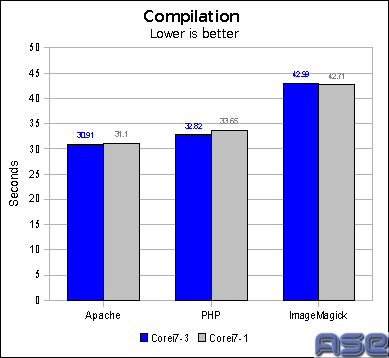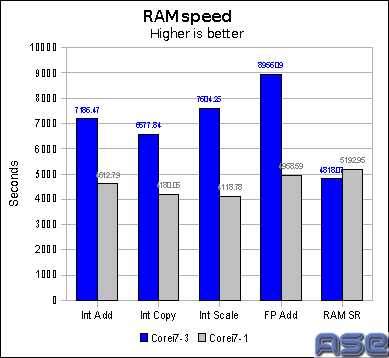Page 2: Results, Conclusion
Results:
We will be focusing on real world testing. Compilation and transcoding test suites were used for the real world benchmarking. RAMspeed was used for a highly synthetic test. You will see the big difference in how synthetic tests can really skew results. What we will focus on is how triple channel can improve your overall speed. In all graphs, the blue indicates the triple channel while the gray is the single channel.
First up are the transcoding tests. Well, these are more or less regular encoding tests since they take a raw wav file and encode it to some compressed type of file. The triple channel performance overall is slightly better in most tests. In these tests, lower is better. Take these results at face value, you probably won't see many gains unless you are doing a load of encoding. Video compression should be faster, though. If you are a video editor, triple channel should help you out overall.
Next up are the compilation tests. In this case, the triple channel is still slightly faster than the single channel in all but one test. We are still in the statistical margin of error for these tests. What can be taken from these results is that spread overall, triple channel will give a slight boost.
As for the synthetic tests, triple channel easily beats the single channel in all but one test. The difference in this synthetic test is very high compared to the range of the previous real world tests. This is part of the reason that ASE Labs really focuses only on real world performance.
Conclusion:
While we can take away that triple channel has some advantage in real world use, it is not always the case that we'll be able to see or notice the performance increase. It is logical that the RAMspeed tests would show a high margin of difference for the most part since it is a synthetic test. On the real world tests, the picture is a bit different. We see that at times the triple channel loses by a hair to the single channel setup. All things being equal, the performance difference is negligible.
That doesn't mean that triple or even dual channel is a waste. I/O transfers are a huge bottleneck in computing power. Anything that can be done to increase the speed of I/O is helpful. There was a minor performance increase in triple channel over the entire test range and it is good to see when technologies work. We can probably assume that triple channel memory is here to stay and when later motherboard are released, it should only get better and better. Regardless, anything dealing with memory intensive applications will see a marginal benefit using triple channel. We are in interesting times once again in computing and it is good to see new developments happening.
We will be focusing on real world testing. Compilation and transcoding test suites were used for the real world benchmarking. RAMspeed was used for a highly synthetic test. You will see the big difference in how synthetic tests can really skew results. What we will focus on is how triple channel can improve your overall speed. In all graphs, the blue indicates the triple channel while the gray is the single channel.
First up are the transcoding tests. Well, these are more or less regular encoding tests since they take a raw wav file and encode it to some compressed type of file. The triple channel performance overall is slightly better in most tests. In these tests, lower is better. Take these results at face value, you probably won't see many gains unless you are doing a load of encoding. Video compression should be faster, though. If you are a video editor, triple channel should help you out overall.
Next up are the compilation tests. In this case, the triple channel is still slightly faster than the single channel in all but one test. We are still in the statistical margin of error for these tests. What can be taken from these results is that spread overall, triple channel will give a slight boost.
As for the synthetic tests, triple channel easily beats the single channel in all but one test. The difference in this synthetic test is very high compared to the range of the previous real world tests. This is part of the reason that ASE Labs really focuses only on real world performance.
Conclusion:
While we can take away that triple channel has some advantage in real world use, it is not always the case that we'll be able to see or notice the performance increase. It is logical that the RAMspeed tests would show a high margin of difference for the most part since it is a synthetic test. On the real world tests, the picture is a bit different. We see that at times the triple channel loses by a hair to the single channel setup. All things being equal, the performance difference is negligible.
That doesn't mean that triple or even dual channel is a waste. I/O transfers are a huge bottleneck in computing power. Anything that can be done to increase the speed of I/O is helpful. There was a minor performance increase in triple channel over the entire test range and it is good to see when technologies work. We can probably assume that triple channel memory is here to stay and when later motherboard are released, it should only get better and better. Regardless, anything dealing with memory intensive applications will see a marginal benefit using triple channel. We are in interesting times once again in computing and it is good to see new developments happening.




